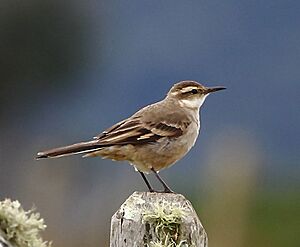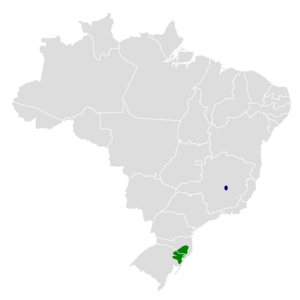Long-tailed cinclodes facts for kids
Quick facts for kids Long-tailed cinclodes |
|
|---|---|
 |
|
| at Urupema, Santa Catarina state, Brazil | |
| Conservation status | |
| Scientific classification | |
| Genus: |
Cinclodes
|
| Species: |
pabsti
|
 |
|
The long-tailed cinclodes (Cinclodes pabsti) is a special bird found only in Brazil. It belongs to the ovenbird family, called Furnariidae. This bird is currently listed as Near Threatened, which means its population is getting smaller.
Contents
About the Long-tailed Cinclodes
Bird Family and Types
The long-tailed cinclodes is a unique member of the Cinclodes group. It's not very closely related to other birds in its genus.
There are two types, or subspecies, of the long-tailed cinclodes:
- C. p. pabsti (named by Helmut Sick in 1969)
- C. p. espinhacensis (discovered in 2012)
Even though C. p. espinhacensis was first thought to be a separate species, it's very similar to C. p. pabsti. They don't have many differences in their genes or how they look.
What's in a Name?
The bird's scientific name, pabsti, honors a Brazilian plant expert named Guido Frederico João Pabst.
What Does It Look Like?
The long-tailed cinclodes is a fairly large bird. It is about 20 to 22 centimeters (8 to 8.7 inches) long. It weighs between 43 and 55 grams (1.5 to 1.9 ounces).
Both male and female birds look the same. They have a long, straight beak.
- They have a clear white stripe above their eye, called a supercilium.
- A dark band goes through their eye and widens over their ears.
- Their upper body is grayish-brown, with a slightly darker head.
- Their wings have two wide, light cinnamon-buff bars.
- Their tail is dark brown with light tips on the outer feathers.
- Their throat is white, which stands out from their pale yellowish-brown belly.
- They have brown eyes, a black beak (sometimes with a light bottom part), and gray to black legs and feet.
The C. p. espinhacensis subspecies is a bit smaller and lighter. It has lighter underparts and darker upperparts compared to the main subspecies.
Where Does It Live?
Habitat of C. p. pabsti
The C. p. pabsti subspecies lives in southeastern Brazil. You can find it in parts of Santa Catarina and Rio Grande do Sul.
It likes open areas like:
- Temperate grasslands
- Pastures
- Farm fields
It often lives near water, rocky places, or even close to houses. This bird can be found at elevations between 750 and 1,700 meters (2,460 and 5,580 feet) above sea level.
Habitat of C. p. espinhacensis
The C. p. espinhacensis subspecies lives in a small area of the Serra do Espinhaço mountains in Minas Gerais, Brazil.
It prefers a special mountain grassland called campos rupestres. This area has a mix of rocky spots and open fields. It lives at elevations from about 1,100 to 1,500 meters (3,600 to 4,900 feet).
Behavior and Life
Movement
The long-tailed cinclodes stays in its home area all year round. It does not migrate.
Feeding Habits
This bird mainly eats arthropods, like insects and spiders. It probably eats other small invertebrates too.
It usually looks for food alone or in pairs. It searches for its prey on the ground, in the grass, and along the edges of water. The C. p. espinhacensis subspecies also looks for food on rocky outcrops.
Reproduction
The long-tailed cinclodes lays its eggs during the spring and summer in the southern hemisphere. It is thought that these birds stay with one partner for life.
They build their nests using grass and feathers. They often place their nests in:
- Cracks in rocks
- Tunnels they dig in rocky soil banks
- Sometimes, even in holes in houses
We don't know much more about how they raise their young.
Vocalization
The song of the C. p. pabsti subspecies is a "very high, short, sharp, rattling sound" that gets louder. They sing it from a perch or while flying. Their call sounds like a "descending 'tseeoo'".
The song of C. p. espinhacensis is a "series of notes" that first get longer, stronger, and higher, then slowly decrease. Their call is similar to the other subspecies but longer.
Conservation Status
Why It's Near Threatened
The IUCN (International Union for Conservation of Nature) first thought the long-tailed cinclodes was not in danger. But in 2007, they changed its status to Near Threatened. This means the bird's population is at risk.
The main reasons for this are:
- It lives in a small area.
- Its habitat is being damaged, especially by new pine tree farms.
We don't know exactly how many long-tailed cinclodes there are, but their numbers are believed to be going down.
Subspecies Status
The C. p. pabsti subspecies is considered uncommon to fairly common. It lives in at least one protected area.
The C. p. espinhacensis subspecies is only found in a few places in the Serra do Espinhaço mountains. Its habitat is threatened by:
- Tourism
- Mining
- Land being changed for pastures and farms
However, this subspecies does live in and near Serra do Cipó National Park, which helps protect it.


